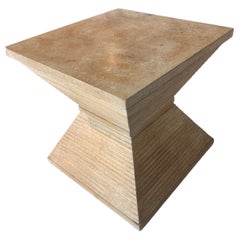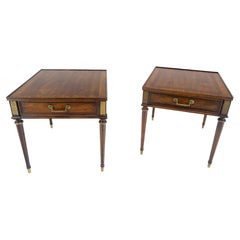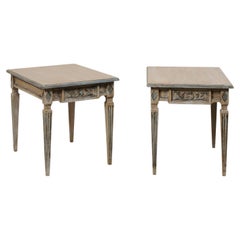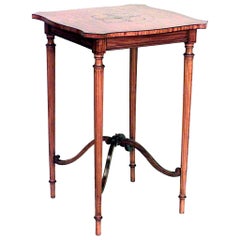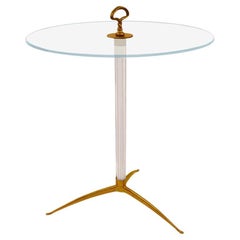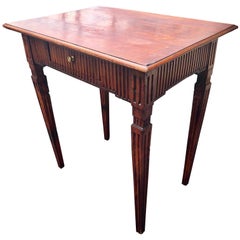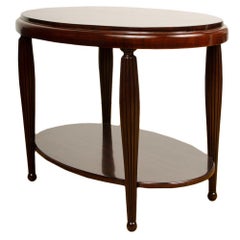Fluted End Table
Vintage 1970s American Mid-Century Modern End Tables
Burl
20th Century American Mid-Century Modern End Tables
Brass
20th Century Italian End Tables
Wood
2010s Canadian Modern End Tables
Metal
Antique 19th Century British Sheraton End Tables
Satinwood
Mid-20th Century End Tables
Brass
Antique Late 18th Century French Louis XVI End Tables
Brass
Vintage 1950s American End Tables
Marble
2010s End Tables
Mahogany
20th Century American Art Deco End Tables
Oak
20th Century American Mid-Century Modern End Tables
Burl
Late 20th Century Side Tables
Wood
Mid-20th Century Unknown Empire Side Tables
Brass
20th Century American End Tables
Marble
20th Century French End Tables
20th Century French End Tables
20th Century End Tables
Vintage 1960s American End Tables
Marble
20th Century American Mid-Century Modern End Tables
20th Century End Tables
Antique 19th Century British Georgian End Tables
Vintage 1960s American End Tables
Vintage 1920s French Directoire End Tables
Carrara Marble, Brass
Vintage 1960s Mid-Century Modern End Tables
20th Century French Louis XVI End Tables
Antique Early 1900s English Edwardian End Tables
Mahogany
Vintage 1960s French Side Tables
Vintage 1960s Italian Side Tables
Vintage 1980s Philippine Modern Side Tables
Marble
Vintage 1960s Italian Mid-Century Modern Side Tables
Brass
Antique 19th Century Dessert Tables and Tilt-top Tables
Mahogany
Vintage 1970s Mid-Century Modern Side Tables
Bamboo, Wood
Vintage 1950s French Neoclassical Side Tables
Brass
Vintage 1940s American Mid-Century Modern Side Tables
Brass
Vintage 1940s French Neoclassical Side Tables
Brass
Vintage 1950s French Louis XVI Coffee and Cocktail Tables
Antique Early 19th Century Italian Neoclassical End Tables
Wood
Mid-20th Century European End Tables
Brass
Mid-20th Century American Mid-Century Modern End Tables
Vintage 1960s American End Tables
Walnut, Mahogany
Mid-20th Century French End Tables
Walnut
Vintage 1960s Italian Mid-Century Modern End Tables
Glass
Vintage 1950s Italian Mid-Century Modern End Tables
Bronze
Vintage 1970s North American Hollywood Regency Side Tables
Marble
Mid-20th Century Folk Art Tray Tables
Hardwood, Paint
Mid-20th Century French Mid-Century Modern Side Tables
Brass
Vintage 1950s Swedish Mid-Century Modern Night Stands
Mahogany
20th Century American End Tables
Vintage 1940s American End Tables
Mahogany
20th Century American End Tables
Vintage 1950s French End Tables
Late 20th Century Italian Modern End Tables
Travertine
20th Century American Night Stands
Mahogany
20th Century American Night Stands
Walnut, Oak
20th Century American Night Stands
Walnut
Vintage 1970s American Mid-Century Modern Night Stands
Brass
Vintage 1960s Italian Side Tables
Brass
Mid-20th Century Empire End Tables
Brass
Fluted End Table For Sale on 1stDibs
How Much is a Fluted End Table?
Finding the Right Tables for You
The right vintage, new or antique tables can help make any space in your home stand out.
Over the years, the variety of tables available to us, as well as our specific needs for said tables, has broadened. Today, with all manner of these must-have furnishings differing in shape, material and style, any dining room table can shine just as brightly as the guests who gather around it.
Remember, when shopping for a dining table, it must fit your dining area, and you need to account for space around the table too — think outside the box, as an oval dining table may work for tighter spaces. Alternatively, if you’ve got the room, a Regency-style dining table can elevate any formal occasion at mealtime.
Innovative furniture makers and designers have also redefined what a table can be. Whether it’s an unconventional Ping-Pong table, a brass side table to display your treasured collectibles or a Louis Vuitton steamer trunk to add an air of nostalgia to your loft, your table can say a lot about you.
The visionary work of French designer Xavier Lavergne, for example, includes tables that draw on the forms of celestial bodies as often as they do aquatic creatures or fossils. Elsewhere, Italian architect Gae Aulenti, who looked to Roman architecture in crafting her stately Jumbo coffee table, created clever glass-topped mobile coffee tables that move on bicycle tires or sculpted wood wheels for Fontana Arte.
Coffee and cocktail tables can serve as a room’s centerpiece with attention-grabbing details and colors. Glass varieties will keep your hardwood flooring and dazzling area rugs on display, while a marble or stone coffee table in a modern interior can showcase your prized art books and decorative objects. A unique vintage desk or writing table can bring sophistication and even a bit of spice to your work life.
No matter your desired form or function, a quality table for your living space is a sound investment. On 1stDibs, browse a collection of vintage, new and antique bedside tables, mid-century end tables and more .
- What are end tables?1 Answer1stDibs ExpertFebruary 22, 2021End tables are small tables that sit beside a larger piece of furniture. The height of an end table is generally that of an arm of a chair.
- How high are end tables?1 Answer1stDibs ExpertMay 3, 2024How high end tables are varies. Most pieces are 18 to 24 inches tall. To ensure easy access to the tabletop from a sofa or chair, choose a table that is within 2 inches of the height of its arm. For example, if your sofa's arm is 20 inches tall, you could choose a table between 18 and 22 inches in height. Shop a wide range of end tables on 1stDibs.
- What are end tables used for?1 Answer1stDibs ExpertSeptember 25, 2019
End tables typically hold lamps, coasters and other items to keep them within easy reach from the sofa or chair they are next to.
- 1stDibs ExpertAugust 26, 2024The difference between an accent table and an end table comes down to how you use them. Accent tables function primarily as decorations and may be placed almost anywhere in a room. The purpose of an end table is to provide storage space next to a sofa or loveseat. Most people use them in pairs, with one placed on either side of the focal furnishing in a seating area. Find a large collection of accent tables and end tables on 1stDibs.
- 1stDibs ExpertMay 5, 2023There are two differences between end tables and side tables: function and size. Typically, end tables go beside a chair or at opposite ends of a sofa and have smaller tabletops, while side tables go toward the sides of seating areas or against walls and feature a larger surface area. However, many people use the words side and end tables interchangeably, so these differences may not always apply. On 1stDibs, shop a variety of end and side tables.
- 1stDibs ExpertApril 5, 2024Yes, end tables are generally taller than coffee tables.
The term “end table” is frequently used interchangeably with “coffee table,” and while these two furnishings have much in common, each table type offers its own distinctive benefits in your space.
Your end table is likely going to stand as tall as the arms of your sofa, and its depth will match the seating. These attributes allow for tucking the table neatly at the end of your sofa in order to provide an elevated surface between your seating and the wall. End tables are accent pieces — they’re a close cousin to side tables, but side tables, not unlike the show-stealing low-profile coffee table, are intended to be positioned prominently and have more to do with the flow and design of a room than an end table, which does a great job but does it out of the way of everything else.
Find all kinds of antique and vintage tables on 1stDibs. - 1stDibs ExpertJune 15, 2023The best height for an end table depends on the sofa or chair beside it. Generally, an end table should be around 3 inches shorter than the arm. A table that is the same height as the arm may also work, but avoid buying tables that are higher than the arm because taller pieces could make it hard to reach objects stored on the tabletops. On 1stDibs, shop a range of end tables.
- 1stDibs ExpertMay 5, 2023You can use a number of things in place of an end table. Place a stool, chest, trunk, barrel or crate beside your sofa or chair, or use a bar cart or freestanding tray to rest a lamp and other objects on. If there is a wall nearby, you can even install a floating shelf within arm’s reach. On 1stDibs, shop a collection of living room furniture.
- 1stDibs ExpertSeptember 23, 2024What the tables at the end of couches are called can vary. However, the most common name for tables in this position is end table. You may also see them referred to as side tables, accent tables or occasional tables. On 1stDibs, explore a wide range of end tables.
- 1stDibs ExpertFebruary 13, 2023Bedroom end tables are often called nightstands if they have drawers or cabinet doors included in their designs. Open pieces without built-in storage are sometimes referred to as bedside tables. Shop a collection of nightstands and bedside tables on 1stDibs.
- 1stDibs ExpertSeptember 25, 2019
An end table should be within two inches as high as the chair or sofa it stands next to and equal in depth.
- 1stDibs ExpertFebruary 22, 2021End tables and coffee tables do not need to match. Nevertheless it can be nice to have a similar color scheme or have one set of end tables match and perhaps have the coffee table match a TV stand.
- 1stDibs ExpertApril 5, 2024The difference between a nightstand and an end table is their location: A nightstand is in a bedroom, while an end table is in a living area.
Find end tables on 1stDibs. - 1stDibs ExpertMay 5, 2023Generally, end tables should be about the same height as the arm of your couch. When the tables aren't significantly taller or shorter, you can reach the tabletop to access items or switch on a lamp with greater ease. Shop a range of end tables on 1stDibs.
- 1stDibs ExpertApril 5, 2022The end chairs are called an armchair. Typically found at the head of the table, these specific chairs have armrests and give off a more formal feel. You can shop a collection of armchairs and dining tables from some of the world’s top sellers on 1stDibs.
Read More
20 Inviting Dining Rooms Perfectly Arranged for Entertaining
Top interior designers show — and tell — us how to create delectable spaces for hosting dinner parties.
This Alain Delon–Designed Table Is Almost as Handsome as He Was
Fans of the French film star may be surprised to learn that he had a flair for furniture with sleek lines and disco-era flash.
Uchronia’s Plant Stand Gives Pots a Pretty Perch with All the Trimmings
Like other pieces in the firm’s Candy Box collection, the cheerful limited-edition design showcases French craft.
The Ultimate Guide to Types of Tables for the Home
Whether you’re just moving in or ready to give your home a makeover, our guide will give you pointers on tables that are fitting for every room, nook and hallway.
Is Lionel Jadot the Willy Wonka of Upcycled Belgian Design?
From his massive collaborative workshop in a former paper factory, the designer concocts funky furniture from disused materials, as well as luxe hotel interiors like the new Mix Brussels.
Inspired by the Cosmos, Sandra Nunnerley’s Nova Table Has a Futuristic Feel
The designer’s innovative use of an unexpected material gives this console a lift.
This 19th-Century Gilded Desk Displays a Fanciful Kingdom in Marquetry
The stately piece brings both gravitas and whimsy to any work space.
In Guadalajara, These Luscious Side Tables Are Chiseled from Volcanic Rock
Use them as tables or stools, indoors or out.
